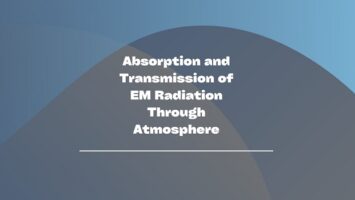Table of Contents
Basic Theory of Interference:
The waves emitted from two coherent sources of light can be written as-
| y1 = a sin ωt y2 = b sin (ωt + Φ) Where “a” and “b” are the respective amplitudes of two waves and Φ is the constant phase angle between two waves. |
According to the Superposition principle,
| y = y1 + y2 ⇒ y = a sin ωt + b sin (ωt + Φ) ⇒ y = a sin ωt + b [sin ωt cos Φ + cos ωt sin Φ] ⇒ y = a sin ωt + b sin ωt cos Φ + b cos ωt sin Φ ⇒ y = sin ωt (a + b cos Φ) + cos ωt (b sin Φ) Put (a + b cos Φ) = R cos θ ………..(i) and b sin Φ = R sin θ ………..(ii) ⇒ y = sin ωt (R cos θ) + cos ωt (R sin θ) ⇒ y = R [sin ωt cos θ + cos ωt sin θ] ⇒ y = R sin (ωt + θ) ………..(A) This resultant wave is the simple harmonic wave with amplitude “R” and phase difference θ. |
Amplitude of Resultant Wave:
| Square and add (i) and (ii), we have ⇒ (a + b cos Φ)2 + (b sin Φ)2 = (R cos θ)2 + (R sin θ)2 ⇒ a2 + b2 cos2 Φ + 2ab cos Φ + b2 sin2 Φ = R2 cos2 θ + R2 sin2 θ ⇒ a2 + b2 (cos2 Φ + sin2 Φ) + 2ab cos Φ = R2 (cos2 θ + sin2 θ) ⇒ a2 + b2 + 2ab cos Φ = R2 ⇒ R = √(a2 + b2 + 2ab cos Φ) ………..(B) Equation (B) is the expression for the amplitude of the resultant wave. |
Resultant Intensity of the Wave:
We know, the resultant intensity is directly proportional to the square of the amplitude of the resultant wave i.e.,
| I ∝ R2 ⇒ I ∝ (a2 + b2 + 2ab cos Φ) ………..(C) |
For Constructive Interference:
| I should be maximum. From (C), cos Φ should be maximum. ⇒ cos Φ = +1 ⇒ cos Φ = cos 0°, cos 2π, cos 4π, cos 6π, ………. ⇒ Φ = 0, 2π, 4π, 6π, ………. ⇒ Φ = 2nπ where n = 0, 1, 2, 3, ………. If x is the path difference between the two waves corresponding to phase difference Φ, then ⇒ x = (λ/2π) Φ ⇒ x = (λ/2π) (2nπ) ⇒ x = nλ Thus condition for constructive interference is that the phase difference between two waves reaching the point should be zero or an even integral multiple of π. In other words, the path difference between the two waves reaching the point should be zero or an integral multiple of the full wavelength. |
For Destructive Interference:
| I should be minimum. From (C), cos Φ should be minimum. ⇒ cos Φ = -1 ⇒ cos Φ = cos π, cos 3π, cos 5π, ………. ⇒ Φ = π, 3π, 5π, ………. ⇒ Φ = (2n – 1) π where n = 1, 2, 3, ………. The corresponding path difference between the two waves will be ⇒ x = (λ/2π) Φ ⇒ x = (λ/2π) (2n – 1) π ⇒ x = (2n -1) (λ/2) Hence condition for destructive interference is that the phase difference between the two waves reaching the point should be an odd integral multiple of π. In other words, the path difference between the two waves reaching the point should be an odd integral multiple of half wavelength. |
Important Notes:
| (1) We know R = √(a2 + b2 + 2ab cos Φ) For Constructive Interference cos Φ = +1 ⇒ Rmax = √(a2 + b2 + 2ab . 1) ⇒ Rmax = √(a + b)2 ⇒ Rmax = (a + b) Also, we know ⇒ Imax ∝ R2max ⇒ Imax ∝ (a + b)2 ⇒ Imax = k (a + b)2 ………..(D) Similarly, For Destructive Interference Rmin = (a – b) and Imin = k (a – b)2 ………..(E) Divide (D) by (E) Imax/Imin = k (a + b)2/k (a – b)2 ⇒ Imax/Imin = (a + b)2/(a – b)2 (2) We know, R2 = a2 + b2 + 2ab cos Φ Put a2 = I1 ⇒ a = √I1 b2 = I2 ⇒ b = √I2 R2 = IR ⇒ R = √IR IR = I1 + I2 + 2 √I1 √I2 cos Φ This is the expression for resultant intensity due to the superposition of two waves. (3) If W1 and W2 be the width of the slits, then W1/W2 = I1/I2 = a2/b2 |
Numericals:
| Example- If two waves due to two sources having an intensity ratio of 100 : 4 interfere, then find the ratio of the intensities at maximum and minimum. Solution- Here I1/I2 = a2/b2 = 100/4 Therefore, a/b = 10/2 = 5/1 Now, Imax/Imin = (a + b)2/(a – b)2 ⇒ Imax/Imin = (a/b + 1)2/(a/b – 1)2 ⇒ Imax/Imin = (5 + 1)2/(5 – 1)2 ⇒ Imax/Imin = 36/16 ⇒ Imax/Imin = 2.25 Hence the ratio of the intensities at maximum and minimum is 2.25. |
| Example- Two waves X and Y are traveling along the same path in the same direction. Their frequencies are the same but the amplitude of Y is double that of X. If the intensity at P due to X alone is I0. What will be the intensity I due to both sources at P when the phase difference between them is (i) 0 (ii) π/2 (iii) π? Solution- The resultant amplitude R due to two waves of amplitude “a” and “b” and having a phase difference of Φ is given by R2 = a2 + b2 + 2ab cos Φ Here b = 2a (i) When Φ = 0°, since cos 0° = 1 R2 = a2 + (2a)2 + 2a (2a) = 9a2 ∴ I/I0 = R2/a2 = 9 ⇒ I = 9I0 (ii) When Φ = π/2, since cos π/2 = 0 R2 = a2 + (2a)2 = 5a2 ∴ I = 5I0 (iii) When Φ = π, since cos π = -1 R2 = a2 + (2a)2 – 2a (2a)= a2 ∴ I = I0 |









Comments (No)